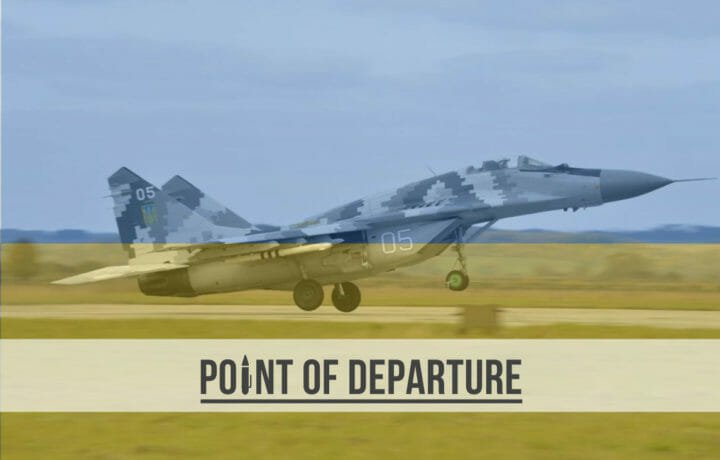The Ghost of Kyiv story is almost too good to be true. And as I always say, when something seems too good to be true, it’s usually because it is too good to be true.
In the early hours following Russia’s invasion into Ukraine, the rumors spread like wildfire. A heroic Ukrainian MIG-29 pilot, flying in contested skies against incredible odds, shot down six Russian fighters in a single, fateful day over the capitol city. Within days, the fighter ace added another four Russian aircraft to his scorecard. And the legend of the Ghost of Kyiv was born.
THE GHOST AND THE GRANDMA
Word of the Ghost spread across the world, as videos, images, and even social media posts went viral. “Hello, Russian villain, I’m coming for your soul!” the Ghost threatened in a post shared by the Ukrainian General Staff. Mainstream media picked up the stories, t-shirts and stickers were offered for sale, and the Ghost quickly became a legend in our time. An urban legend, maybe, but still a legend.
Even as the legend of the Ghost began to fade, another took its place: the Panther of Kharkiv: Mikael, a cat trained to spot and direct the location of Russian snipers by following “laser dots.” Now, anyone who has felt the need to torment a cat with a laser pointer probably laughed this one off, but it, too, caught fire and went viral. Another urban legend – even a silly one – that people wanted to believe in.
Then came the story of the pickle-packin’ grandma who was reported to have taken out a Russian drone with a jar of pickles (later “confirmed” to be a jar of pickled tomatoes). During an interview, the grandmother, Elena, said that she was smoking on her balcony just before dawn when she heard the bussing from the nearby drone. Arming herself with the jar of picked tomatoes under her chair – where else would a self-respecting grandmother keep her picked goods – took aim, and in true Ukrainian fashion took out the drone. She also pointed out that initial reports were mistaken: no cucumbers for her; she prefers tomatoes with plums.
URBAN MYTHS AND LEGENDS
The internet sleuths were quick to point out that none of these stories were likely true – that they were the fabrications of a people desperate for something – or someone – to believe in. Some went as far as to point out how such stories can “mislead the public” about the realities of war. Not that it takes that much to mislead the public. People tend to believe whatever they see in the latest meme without bothering to confirm facts and sources.
But I digress.
Urban myths are nothing new to war. The Templar Knights are a veritable cornucopia of urban myths. The origin of Taps, the military bugle call, is surrounded by urban myth. During World War I, British intelligence allowed a battlefield rumor to spread about a mythical army of Russian Cossacks riding east toward the German lines. In the Second World War, it was the USS Eldridge, a Cannon-class destroyer escort rumored to have been rendered invisible during a military experiment at the Philadelphia Naval Shipyard (thus, the Philadelphia Experiment).
Some people still believe that Fred Rogers (of Mister Rogers fame) was a Marine scout sniper during the Vietnam War, or that Jerry Mathers (who played the title role in Leave it Beaver) fought and died there. During the Gulf War, rumors of the Ether Bunny – a rogue medic who reportedly assaulted male soldiers after dosing them with ether – were rampant. When we returned there a decade later, I remember Iraqis asking me if my Army-issue Wiley-X sunglasses were imbued with X-ray capability – a common urban myth among civilians.
why urban myths Like Ghost of Kyiv matter
Folklore. That’s really what we’re talking about. Urban legends are an important part of our culture, helping people make sense of the world around them. We share those legends as a means of social engagement, like warning people around a campfire in the woods that a man with a hook hand has been seen wandering in the night. They convey lessons, often as simple as sleep with one eye open.
Psychologically, urban myths are powerful tools. In the hands of experts, they can be used to shape opinions and behaviors, evoke reactions, and even to persuade. Threaded into a narrative, they can underpin a psychological warfare effort, not unlike Putin’s disinformation campaign that presaged his invasion of Ukraine. That it all came crashing down so spectacularly is a testament to the power of a counter-narrative, even one built on urban myth. And if it makes Russians nervous, all the better.
While the fact checkers among us might like to cast doubt on the veracity of the urban myths of the war in Ukraine, we need to remember that those legends provide something in short supply there: hope. Take away those urban myths and you’re stealing hope from the very people who need it most. If someone wants to believe in a shadowy Fulcrum ace flying the skies over Kyiv at breakneck speed, let them. If people want to believe that a trained cat is actually hunting down Russian snipers, let them. And if they want to believe that a pickle-packin’ grandma is knocking drones out of the air, let them.
People want to believe. Let them.




